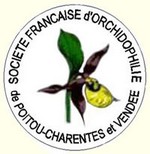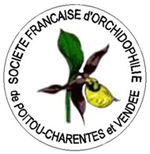PDF 18.4 EPILOGUE
CONTRIBUTION A L’INVENTAIRE DE L’ORCHIDOFLORE DE LA FACADE ATLANTIQUE Cette publication s’inscrit dans le cadre du Contrat d’Objectif passé entre la Société Française d’Orchidophilie de Poitou-Charentes et de Vendée (SFO PCV) et le Conseil Régional de Poitou-Charentes.
ETUDE DES POPULATIONS ARANIFORMES A FLORAISON PRECOCE
Epilogue |
| Télécharger le document PDF (clic gauche sur l’icône) |
||
| Retour au sommaire |
 PDF 18.4
PDF 18.4 |
Retour à la page précédente |
Aller à la page suivante |
| Résumé L’approche locale de l’étude des populations à floraison précoce de la façade atlantique ne nous a pas paru satisfaisante. La problématique présence de l’Ophrys marzuola en Poitou-Charentes ainsi que le doute maintenu sur l’introgression de l’Ophrys des Olonnes par une espèce arachnitiforme nous ont conduits à nous intéresser aux populations d’Ophrys marzuola et aux populations arachnitiformes que nous sommes allés échantillonner dans la région de la Moyenne-Garonne, dans le Tarn et Garonne et le Gers. L’étude a révélé qu’une parfaite continuité pouvait être établie entre les populations d’Ophrys marzuola de la Moyenne-Garonne et nos populations araniformes à floraison précoce. Ces dernières bien que issues du complexe Ophrys exaltata ne peuvent cependant plus y être assimilées, car ne répondant plus aux critères fondamentaux qui le caractérisent : angle gynostème/labelle plus fermé, caractère hétérochrome du champ basal par rapport au labelle, ainsi qu’un aplatissement de la cavité stigmatique. Mots clés Orchidées indigènes ; façade atlantique ; populations araniformes précoces ; Ophrys des Olonnes ; Ophrys de Saint-Loup ; Ophrys passionis ; Ophrys aranifera ; Ophrys araneola ; Complexe Ophrys exaltata ; Ophrys marzuola ; Ophrys arachnitiformis synthèse ; hybridation ; populations hybrides Abstract The local approach of the study of early flowering populations of the Atlantic coast did not seem satisfactory to us. Because the presence of Ophrys marzuola in Poitou-Charentes was problematic and because the introgression of Olonnes Ophrys by arachnitiformis species was still doubtful, we decided to get interested in Ophrys marzuola populations and arachnitiformis populations that we sampled in the area of Middle Garonne, Tarn-Garonne department and Gers department. The study showed that a perfect continuity could be established between the populations of Ophrys marzuola of Middle Garonne and our early flowering araniformis populations. The latter, although originated from the complex Ophrys exaltata, can no longer be part of this complex because they no longer meet the basic criteria that characterize it : more closed gynostemium / lip angle heterochromatic nature of the basal field relative to the lip, and a flattening stigmatic cavity. Key words Indigenous orchids ; Atlantic coastline ; early araniformis populations ; Olonnes Ophrys ; Saint-Loup Ophrys ; Ophrys passionis ; Ophrys aranifera ; Ophrys araneola ; Ophrys exaltata complex ; Ophrys marzuola ; Ophrys arachnitiformis ; synthesis ; hybridization ; hybrid populations. |
Documents joints à cet article :
Articles associés
24/04/2019 - SOMMAIRE
Contribution à l’inventaire de l’orchidoflore de le façade atlantique. - COB 2014/2015/2016
Contribution à l’inventaire de l’orchidoflore de le façade atlantique. - COB 2014/2015/2016
02/05/2017 - BIBLIOGRAPHIE ET SOURCES DOCUMENTAIRES.
11/10/2016 - PDF 18.4 EPILOGUE
16/10/2016 - ETUDE DES POPULATIONS ARANIFORMES A FLORAISON PRECOCE - BIBLIOGRAPHIE ET SOURCES DOCUMENTAIRES
01/05/2017 - REMERCIEMENTS
03/10/2017 - ETUDE DES POPULATIONS FUCIFLOROÏDES A FLORAISON TARDIVE - ETUDE DE LA MACULE ET SPECTRE MACULAIRE
21/12/2017 - OPHRYS ARANIFORMES A FLORAISONN PRECOCE DE LA FACADE ATLANTIQUE - Description de l’Ophrys suboccidentalis
07/01/2018 - SYNTHESE PRECOCES
19/09/2016 - PDF 5 - ETUDE DES POPULATIONS ARANIFORMES A FLORAISON PRECOCE - EUDE BIOMETRIQUE DES CARACTERES FLORAUX
Préambule
Préambule
19/09/2016 - PDF 7 - ETUDE DES POPULATIONS ARANIFORMES A FLORAISON PRECOCE - MESURE DE L’ANGLE GYNOSTEME/LABELLE.
19/09/2016 - PDF19. ETUDE DES POPULATIONS ARANIFORMES A FLORAISON PRECOCE ETUDE BIOMETRIQUE DES CARACTERES VEGETATIFS IN SITU.
12/10/2016 - PDF 20.1 ETUDE DES OPHRYS PRECOCES DE LA FACADE ATLANTIQUE - ETUDE GENETIQUE ET MOLECULAIRE



